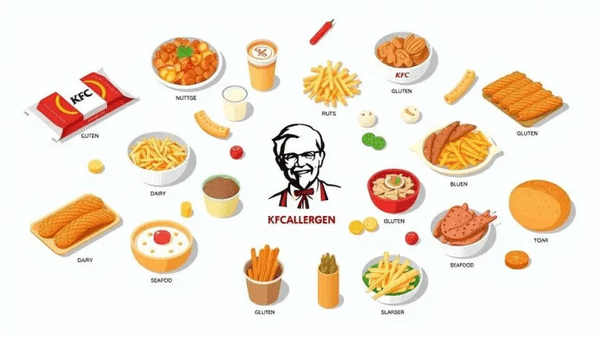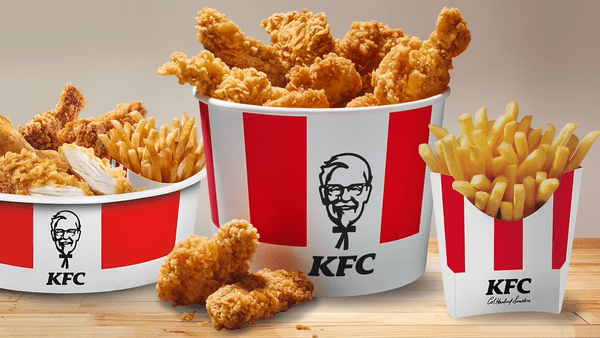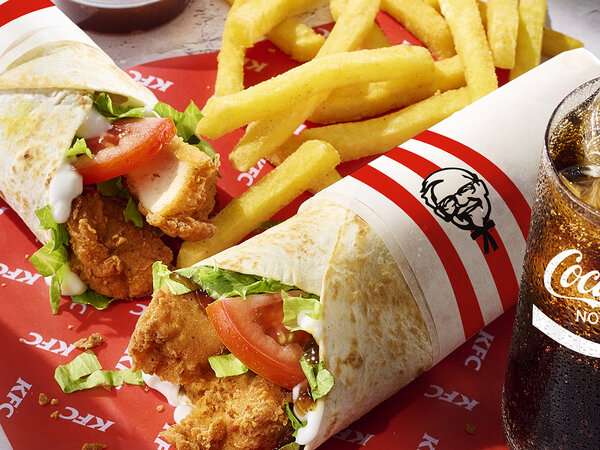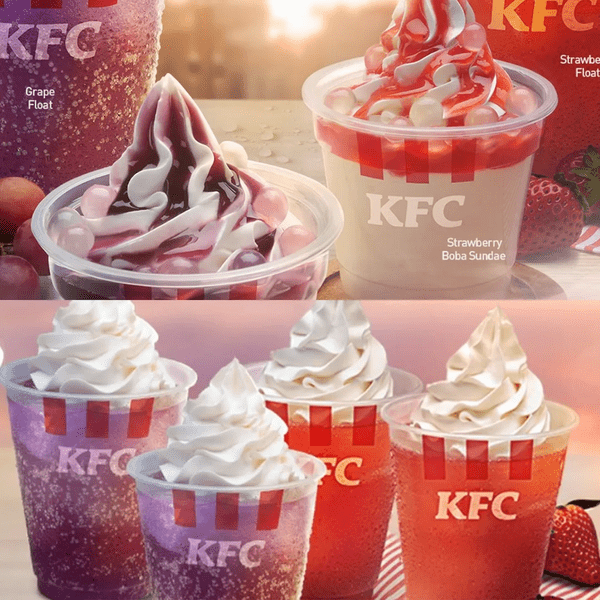Navigating fast food options with food allergies can be challenging, but having accurate allergen information makes it significantly easier. The KFC allergen menu provides essential details for anyone with dietary restrictions or sensitivities who wants to enjoy their famous chicken safely. This comprehensive guide breaks down exactly what’s in your favorite KFC items, helping you make informed choices whether you’re dealing with gluten sensitivity, dairy allergies, or other dietary concerns. For an in-depth look at all menu offerings, see KFC menu.
Key Points About This Guide:
- Complete breakdown of all major allergens across the entire KFC menu
- Detailed analysis of cross-contact risks in KFC kitchens
- Practical ordering tips for people with specific allergies
- Access to official KFC allergen resources and verification tools
Approximately 32 million Americans live with food allergies, making clear allergen information critically important. While this guide is thoroughly researched and regularly updated, please note that it’s unofficial and independent from KFC. Always verify the most current information directly with your local restaurant, as ingredients and preparation methods may vary by location or change over time.
1. Complete KFC Allergen Chart (2025 U.S. Edition)
The KFC allergen menu provides essential information for anyone with food sensitivities or allergies. This comprehensive chart identifies which menu items contain or may contain any of the nine major allergens: wheat/gluten, milk, eggs, soy, peanuts, tree nuts, fish, shellfish, and sesame.
To use this chart effectively, look for these key markers:
- Contains: The allergen is definitely present in the food
- May Contain: The allergen might be present due to cross-contact
- Does Not Contain: The allergen is not an ingredient, but cross-contact is still possible
Remember that all KFC items are prepared in shared kitchens, creating potential cross-contact risks even for items marked “Does Not Contain.”
| Menu Item | Wheat/Gluten | Milk | Eggs | Soy | Peanuts | Tree Nuts | Fish | Shellfish | Sesame |
|---|---|---|---|---|---|---|---|---|---|
| Original Recipe Chicken | Contains | Contains | Contains | Contains | Does Not Contain | Does Not Contain | Does Not Contain | Does Not Contain | May Contain |
| Extra Crispy Chicken | Contains | Contains | Contains | Contains | Does Not Contain | Does Not Contain | Does Not Contain | Does Not Contain | May Contain |
| Kentucky Grilled Chicken | Does Not Contain | Does Not Contain | Does Not Contain | Contains | Does Not Contain | Does Not Contain | Does Not Contain | Does Not Contain | Does Not Contain |
| Chicken Sandwich | Contains | Contains | Contains | Contains | Does Not Contain | Does Not Contain | Does Not Contain | Does Not Contain | Contains |
| Spicy Chicken Sandwich | Contains | Contains | Contains | Contains | Does Not Contain | Does Not Contain | Does Not Contain | Does Not Contain | Contains |
| Chicken Littles | Contains | Contains | Contains | Contains | Does Not Contain | Does Not Contain | Does Not Contain | Does Not Contain | Contains |
| Chicken Pot Pie | Contains | Contains | Contains | Contains | Does Not Contain | Does Not Contain | Does Not Contain | Does Not Contain | Does Not Contain |
| Famous Bowl | Contains | Contains | Contains | Contains | Does Not Contain | Does Not Contain | Does Not Contain | Does Not Contain | Does Not Contain |
| Mashed Potatoes with Gravy | Contains | Contains | Does Not Contain | Contains | Does Not Contain | Does Not Contain | Does Not Contain | Does Not Contain | Does Not Contain |
| Coleslaw | Does Not Contain | Does Not Contain | Contains | Contains | Does Not Contain | Does Not Contain | Does Not Contain | Does Not Contain | Does Not Contain |
| Biscuits | Contains | Contains | Contains | Contains | Does Not Contain | Does Not Contain | Does Not Contain | Does Not Contain | Does Not Contain |
| Mac & Cheese | Contains | Contains | Contains | Contains | Does Not Contain | Does Not Contain | Does Not Contain | Does Not Contain | Does Not Contain |
| Secret Recipe Fries | Contains | Does Not Contain | Does Not Contain | Contains | Does Not Contain | Does Not Contain | Does Not Contain | Does Not Contain | Does Not Contain |
| KFC Sauce | Contains | Contains | Contains | Contains | Does Not Contain | Does Not Contain | Does Not Contain | Does Not Contain | Contains |
| Honey BBQ Sauce | Contains | Does Not Contain | Does Not Contain | Contains | Does Not Contain | Does Not Contain | Does Not Contain | Does Not Contain | Does Not Contain |
| Chocolate Chip Cookie | Contains | Contains | Contains | Contains | May Contain | May Contain | Does Not Contain | Does Not Contain | May Contain |
1.1 Understanding Allergen Terminology at KFC
When reviewing the KFC allergen menu, it’s important to understand the specific terminology used to describe potential allergen exposure:
Key Allergen Terms Defined:
- Contains: The allergen is a deliberate ingredient in the product
- May Contain: The allergen isn’t intentionally added but might be present due to shared equipment or manufacturing processes
- Processed in a facility with: The food is made in a facility that also processes the allergen, creating potential for trace amounts
- Cross-contact: Occurs when a food allergen transfers from one food to another unintentionally (different from cross-contamination, which refers to disease-causing organisms)
Major Allergens Explained:
- Wheat/Gluten: Proteins found in wheat, barley, rye, and sometimes oats; gluten sensitivity differs from wheat allergy
- Milk: Includes all dairy proteins like casein and whey
- Eggs: Proteins found in both egg whites and yolks
- Soy: Derived from soybeans, often found in oils, proteins, and emulsifiers
- Peanuts: Legumes (not true nuts) that can cause severe allergic reactions
- Tree Nuts: Includes almonds, walnuts, cashews, pistachios, and others
- Fish: Proteins from finned fish like tuna, salmon, cod
- Shellfish: Includes crustaceans (shrimp, crab) and mollusks (clams, mussels)
- Sesame: Seeds often used in bread products, oils, and Asian cuisine
According to FDA definitions, these nine allergens account for over 90% of serious allergic reactions in the United States.

1.2 How to Use This Allergen Guide Effectively
Following these steps will help you make the safest possible choices when consulting the KFC allergen menu:
- Identify your specific allergen(s) from the list of nine major allergens tracked by KFC
- Cross-reference with the allergen chart to find menu items that don’t contain your allergen(s)
- Consider cross-contact risks even for items marked “Does Not Contain”
- Call ahead to your local KFC to verify current allergen information
- Visit during less busy times when staff can give your order more attention
- Clearly communicate your allergies to the cashier and request they alert the kitchen
- Ask about preparation methods specific to your local restaurant
- Consider requesting fresh gloves for food handling if your allergy is severe
- Bookmark this guide or save a screenshot of the chart for future reference
- Verify with official KFC resources as ingredients may change over time
Remember that no fast food restaurant, including KFC, can guarantee a completely allergen-free environment due to shared cooking equipment and preparation areas.
2. Major Allergens in Popular KFC Menu Categories
Each KFC menu category contains different allergen profiles. Understanding which allergens appear in your favorite items can help you make safer choices based on your specific dietary needs. For a full overview of offerings, pricing, and nutrition, check the ky fried chicken menu with prices.
2.1 Chicken Items: Original Recipe, Extra Crispy & Grilled
Original Recipe Chicken:
- Contains wheat, milk, eggs, and soy
- The signature coating includes wheat flour as the primary ingredient
- Milk proteins appear in the marinade and coating
- Egg is used as a binding agent in the breading process
- Soy is present in the oil blend used for frying
Extra Crispy Chicken:
- Contains higher amounts of wheat, milk, eggs, and soy compared to Original Recipe
- Features a double-breaded coating with significantly more wheat flour
- Contains additional milk proteins in the enhanced breading
- Uses more egg-based binding agents in the thicker coating
- Fried in the same soybean oil blend as Original Recipe
Kentucky Grilled Chicken:
- Contains soy but is free from wheat/gluten, milk, and eggs
- The marinade contains soybean oil and soy-based flavorings
- Represents the most allergen-friendly chicken option at KFC
- Prepared on separate grilling equipment, reducing some cross-contact risks
- Still prepared in the same kitchen, so trace cross-contact remains possible
The grilled chicken represents the best option for those with wheat, gluten, dairy, or egg allergies, though cross-contact is still a consideration in the shared kitchen environment.

2.2 Sandwiches, Wraps & Bowls
KFC’s handheld items and bowls contain multiple allergens from both the chicken components and additional ingredients:
Chicken Sandwiches (Classic and Spicy):
- Contain wheat, milk, eggs, soy, and sesame
- Brioche bun contains wheat, milk, eggs, soy, and sesame seeds
- Chicken filet contains wheat, milk, eggs, and soy (as noted in section 2.1)
- Mayo-based sauces contain eggs
- Pickle slices are generally allergen-free but processed on shared equipment
For more about your sandwich options and ingredients, see the KFC chicken sandwich menu.
Chicken Wraps:
- Contain wheat, milk, eggs, and soy
- Flour tortillas contain wheat
- Sauce packets often contain milk, eggs, or soy
- Chicken contains allergens as noted previously
- Some varieties may contain additional allergens from toppings
Famous Bowls:
- Contain wheat, milk, eggs, and soy
- Mashed potatoes contain milk and may contain wheat from the gravy
- Corn may be cooked with butter (milk)
- Cheese topping contains milk
- Popcorn chicken contains wheat, milk, eggs, and soy
For a breakdown of all bowl options and their ingredients, refer to the KFC Famous Bowl.
The sandwich buns consistently present the highest number of different allergens in this category, making them particularly challenging for those with multiple food allergies.

2.3 Sides & Extras: Biscuits, Mashed Potatoes, Coleslaw & More
KFC’s sides contain varied allergen profiles, with some options being more allergen-friendly than others:
| Side Item | Key Allergens | Specific Ingredients of Concern |
|---|---|---|
| Biscuits | Wheat, Milk, Eggs, Soy | Wheat flour, buttermilk, eggs, soybean oil |
| Mashed Potatoes | Milk, Wheat (with gravy) | Milk, butter, wheat in gravy |
| Gravy | Wheat, Soy | Wheat flour, soy-based ingredients |
| Coleslaw | Eggs, Soy | Mayonnaise (eggs), soybean oil |
| Mac & Cheese | Wheat, Milk, Eggs | Wheat pasta, cheese blend, egg-based ingredients |
| Secret Recipe Fries | Wheat, Soy | Wheat-based coating, fried in soybean oil |
| Corn on the Cob | Milk | Often prepared with butter |
| BBQ Baked Beans | Soy | Soy-based flavorings and preservatives |
To dive deeper into mashed potato ingredients or allergen notes, see the KFC mashed potatoes guide. For everything about iconic sides like biscuits, you’ll enjoy the KFC biscuits article.
The most allergen-friendly sides are generally the BBQ baked beans, corn (if requested without butter), and possibly coleslaw for those without egg allergies. The mashed potatoes (without gravy) may be suitable for those with wheat allergies but not for those with milk allergies.
2.4 Sauces, Dressings & Condiments
Sauces and condiments often contain unexpected allergens. Here’s a breakdown of KFC’s sauce options:
| Sauce/Condiment | Wheat/Gluten | Milk | Eggs | Soy | Other Allergens |
|---|---|---|---|---|---|
| KFC Sauce | Contains | Contains | Contains | Contains | Sesame |
| Honey BBQ | Contains | Does Not Contain | Does Not Contain | Contains | None |
| Buffalo Ranch | Contains | Contains | Contains | Contains | None |
| Honey Mustard | Does Not Contain | Does Not Contain | Contains | Contains | None |
| Buttermilk Ranch | Contains | Contains | Contains | Contains | None |
| Sweet N’ Tangy | Contains | Does Not Contain | Does Not Contain | Contains | None |
| Honey Sauce | Does Not Contain | Does Not Contain | Does Not Contain | Does Not Contain | None |
Honey sauce is typically the most allergen-friendly option, containing no major allergens. Many KFC customers with allergies are surprised to find wheat in sauces like Honey BBQ and Sweet N’ Tangy, which occurs through modified food starch and flavor enhancers.
2.5 Desserts & Beverages
KFC’s dessert options present various allergen concerns:
Desserts:
- Chocolate Chip Cookie: Contains wheat, milk, eggs, soy and may contain peanuts, tree nuts, and sesame
- Cake Slices (where available): Typically contain wheat, milk, eggs, soy and may contain tree nuts
- Parfaits (where available): Contain milk and may contain wheat from cookie pieces
Beverages:
- Fountain Drinks: Generally free from major allergens
- Sweet Tea/Unsweetened Tea: Typically free from major allergens
- Coffee: Free from major allergens but may be prepared with equipment that also handles milk
- Milkshakes (where available): Contain milk and may contain other allergens from flavorings
For a rundown on all beverage choices, flavors, and customizing your drinks, see the KFC beverages guide.
Beverage options represent the safest choices for most people with food allergies at KFC, with plain fountain drinks and unsweetened tea being the least likely to cause allergic reactions.

3. Menu Items Without Major Allergens
While KFC’s menu contains many allergens, certain items may be suitable for those with specific dietary restrictions. Remember that all items are prepared in a shared kitchen environment, so cross-contact is always possible.
Wheat/Gluten-Free Options:
- Kentucky Grilled Chicken (without sauce)
- Coleslaw (verify locally as recipes may vary)
- House Side Salad (without croutons)
- Honey Sauce packets
- Unsweetened beverages (soft drinks, tea, coffee)
Dairy-Free Options:
- Kentucky Grilled Chicken (without sauce)
- Secret Recipe Fries
- BBQ Baked Beans
- Coleslaw
- Honey BBQ Sauce
- Sweet N’ Tangy Sauce
- Honey Sauce
- Unsweetened beverages (soft drinks, tea, coffee)
Egg-Free Options:
- Kentucky Grilled Chicken (without sauce)
- Secret Recipe Fries
- Mashed Potatoes (with or without gravy)
- BBQ Baked Beans
- Corn on the Cob
- Honey BBQ Sauce
- Sweet N’ Tangy Sauce
- Honey Sauce
- Unsweetened beverages (soft drinks, tea, coffee)
Soy-Free Options:
- Limited to certain beverages only, as most KFC food items contain soy oil or soy-derived ingredients
These lists reflect ingredient information only and do not account for cross-contact risks, which are significant at KFC.
3.1 Is Anything at KFC Completely Allergen-Free?
The straightforward answer is no – KFC cannot guarantee any menu item is completely allergen-free due to their preparation methods. According to KFC’s official allergen statement, “all foods are prepared in shared cooking and preparation areas and may come in contact with all ingredients used in the restaurant, including all major FDA allergens.”
This cross-contact risk stems from:
- Shared fryers used for multiple products
- Common preparation surfaces and utensils
- Airborne particles from flour and other ingredients
- Staff handling multiple ingredients without changing gloves
For those with severe or life-threatening allergies, the safest approach may be to avoid KFC entirely. Those with milder sensitivities should assess their personal risk tolerance and communicate clearly with restaurant staff about their specific needs.
4. Cross-Contact Risks at KFC: What You Need to Know
Cross-contact is a significant consideration when evaluating the kentucky fried chicken allergen menu. Understanding the restaurant’s operational setup helps assess potential risks.
KFC restaurants typically operate with:
- Limited kitchen space where multiple menu items are prepared in close proximity
- Shared fryers where different breaded products are cooked in the same oil
- Common preparation surfaces for assembling various menu items
- Staff members who handle multiple ingredients during busy periods
- Flour and breading that can become airborne during the cooking process
This environment creates numerous opportunities for allergens to transfer between foods, even when the allergen isn’t a direct ingredient. For example, grilled chicken (which contains no wheat in its ingredients) may come into contact with breading from Original Recipe or Extra Crispy chicken during preparation or serving.
Staff training on allergens varies by location. While KFC provides allergen information to its restaurants, individual employee knowledge about cross-contact prevention might be limited, especially during peak hours when speed is prioritized.
The reality is that KFC, like most fast-food restaurants, is not designed to accommodate severe food allergies with the same protocols you’d find at allergen-conscious restaurants that use dedicated equipment and preparation areas.

4.1 High-Risk Areas for Cross-Contact at KFC
Certain aspects of KFC’s operations present particularly high risks for allergen cross-contact:
- Fryers: All breaded products (containing wheat, milk, and egg) are cooked in the same oil as fries and other items, transferring proteins between foods
- Breading Stations: The flour mixture used for Original Recipe and Extra Crispy chicken becomes airborne during the breading process, potentially settling on nearby “allergen-free” items
- Tongs and Utensils: The same serving implements are often used for multiple menu items without cleaning between uses
- Preparation Surfaces: The limited counter space means items are often assembled in the same areas, creating opportunities for ingredient transfer
- Gloves: Staff may not change gloves between handling different menu items during busy periods
- Storage Practices: Ingredients and prepared foods are stored in close proximity in warming cabinets and refrigeration units
- Dispensing Equipment: Sauce dispensers and other tools may be shared between products containing different allergens
According to food safety experts, the highest cross-contact risks at KFC are for wheat/gluten, as the flour-based breading is used extensively and can easily spread to other foods through both direct contact and airborne particles.
5. How to Order Safely at KFC with Food Allergies
While the KFC allergy menu provides valuable information, how you order can significantly impact your safety. Follow these steps for the safest possible experience:
- Choose your timing wiselyVisit during off-peak hours (typically 2-4 PM on weekdays) when staff can give your order more attention and the kitchen is less hectic.
- Call ahead to verifyContact your local KFC before visiting to ask about current ingredients and their ability to accommodate your specific allergy.
- Speak directly with a managerRequest to speak with the shift supervisor or restaurant manager, who typically has better training on allergen protocols than frontline staff.
- Be clear and specificUse direct language like “I have a severe allergy to [allergen]” rather than “I can’t eat” or “I’m avoiding” to ensure they understand the seriousness.
- Request special handlingAsk if staff can change gloves, use clean utensils, or take other reasonable measures to reduce cross-contact risk.
- Verify your orderWhen receiving your food, confirm again that it meets your allergen requirements before leaving the counter.
- Check your food carefullyInspect your meal for obvious signs of your allergen before eating (such as breading on what should be grilled chicken).
- Be prepared for reactionsCarry necessary medication (like antihistamines or epinephrine auto-injectors) and know where the nearest emergency medical facility is located.
Sample script for ordering: “Hi, I have a severe allergy to [allergen]. Could you please let the kitchen know? I’d like to order [menu item] without [ingredient]. Could someone please change their gloves when preparing my food?”
5.1 Tips for Specific Allergies at KFC
Different allergies require different approaches when navigating the KFC menu:
Wheat/Gluten Allergy:
- Kentucky Grilled Chicken is your safest protein option
- Avoid all breaded items entirely
- Beware of hidden wheat in gravy, sauces, and marinades
- Understand that airborne flour particles present significant risks
- Consider ordering grilled chicken with no sauce and a side salad (no croutons)
Dairy Allergy:
- Avoid biscuits, mashed potatoes, mac & cheese, and anything with cheese
- Be aware that milk proteins are in the breading of Original and Extra Crispy chicken
- Kentucky Grilled Chicken (no sauce), fries, and certain sides may be options
- Always check sauce ingredients, as many contain dairy
Egg Allergy:
- Avoid all breaded chicken products, as egg is used in the breading
- Stay away from coleslaw (contains mayonnaise) and cookies
- Kentucky Grilled Chicken, fries, and certain sides may be safer
- Be careful with sandwiches, as buns often contain egg and mayo-based sauces
Soy Allergy:
- This is perhaps the most challenging allergy at KFC
- Nearly all menu items contain soy, primarily through soybean oil
- Even grilled chicken marinades typically contain soy
- Beverages may be the only truly soy-free options
- Consider whether your soy allergy is triggered by refined soybean oil (many people can tolerate it)
Peanut/Tree Nut Allergies:
- These are generally easier to manage at KFC, as nuts aren’t common ingredients
- Desserts pose the highest risk for these allergens
- Always check for warnings about items being processed in facilities with nuts
Remember that these suggestions don’t eliminate cross-contact risk and may not be suitable for those with severe allergies.
6. Official KFC Allergen Resources and Tools
To supplement the information in this guide, KFC provides several official resources for allergen information:
KFC’s Online Allergen Calculator:KFC maintains an interactive allergen tool on their official website that allows customers to filter menu items based on specific allergens. This tool is updated when recipes change or new products are introduced. The calculator lets you select multiple allergens to avoid and shows which menu items might be suitable.
Mobile App Features:The KFC app includes allergen information in the nutrition section. Users can access allergen details for any menu item by tapping on the product and selecting “View Nutritional Information.” The app also allows for customized ordering, which can be helpful for removing certain ingredients.
In-Restaurant Resources:Most KFC locations keep printed allergen information binders available upon request. These contain comprehensive ingredient lists and allergen information for all menu items. Nutrition posters displayed in restaurants also include some allergen details, typically focusing on calories and major allergens.
Direct Contact Options:For the most current information, KFC provides these contact options:
- Customer service: 1-800-CALL-KFC (1-800-225-5532)
- Email: customerservice@kfc.com
- Website contact form: www.kfc.com/contact-us
KFC typically updates its allergen information whenever ingredients change or at least twice yearly. The last major update to the KFC allergen menu occurred in January 2025.

6.1 How to Access the Latest KFC Allergen Information
To ensure you’re working with the most current information about KFC’s allergens, follow these steps:
- Visit the official KFC websiteNavigate to www.kfc.com/nutrition and select “Allergens” from the menu options
- Use the allergen filter toolSelect specific allergens to view suitable menu items or click on individual menu items to see their complete allergen profile
- Check the last update dateLook for the “Last Updated” timestamp at the bottom of the allergen page (current as of January 2025)
- Download PDF resourcesAccess printable allergen guides and complete ingredient lists in PDF format for offline reference
- Contact your local restaurantCall directly to verify if they follow standard recipes or have any regional variations
- Ask for verification in-storeRequest to see the allergen information binder, which should be available at all KFC locations
- Follow KFC on social mediaMajor ingredient changes are sometimes announced on their official channels
For verification purposes, you can cross-reference KFC’s allergen information with third-party resources like the AllergyEats restaurant database or the Spokin app, which include user reviews about allergen experiences at specific restaurant locations.
7. Frequently Asked Questions About KFC Allergens
These are the most common questions people ask about the KFC allergen menu:
Q: Does KFC use peanut oil in their cooking?A: No, KFC does not use peanut oil. They primarily use a blend of soybean and canola oils for frying. However, other allergens like wheat, milk, and eggs are present in many menu items and in the cooking environment.
Q: Can I get the Original Recipe chicken without certain allergens?A: Unfortunately, no. The Original Recipe chicken contains wheat, milk, eggs, and soy in its proprietary blend of herbs and spices and cooking method. These ingredients are integral to the recipe and cannot be removed or substituted.
Q: Are KFC’s sauces gluten-free?A: Most KFC sauces contain wheat/gluten. The only sauce that doesn’t contain wheat is the individual Honey Sauce packets. However, even these may be subject to cross-contact in the restaurant environment.
Q: Has KFC ever considered offering allergen-free menu options?A: While KFC has introduced some options with fewer allergens (like grilled chicken), they have not developed truly allergen-free items due to their kitchen setup and cooking processes, which present significant cross-contact risks.
Q: Do allergen profiles vary between different KFC locations?A: While the core recipes are standardized, there can be minor variations between locations, particularly international ones. Additionally, limited-time offers and regional specialties may have different allergen profiles from the standard menu.
Q: Can I trust the allergen information on the KFC website?A: KFC makes efforts to keep their allergen information accurate, but recipes can change without immediate website updates. Always verify with your local restaurant, especially if you have severe allergies.
Q: Is there anything at KFC that’s safe for someone with multiple food allergies?A: For individuals with multiple severe food allergies, KFC presents significant challenges due to shared cooking environments. Beverages may be the safest option, but even those could be subject to cross-contact if the same person handling food also operates the drink station.
7.1 Does KFC Offer Gluten-Free Options?
KFC does not officially offer any certified gluten-free menu items. While some items like the Kentucky Grilled Chicken don’t contain gluten in their ingredient lists, KFC explicitly states they cannot guarantee these items remain gluten-free due to their preparation environment.
The main challenges for creating a truly gluten free KFC menu include:
- Flour is used extensively throughout KFC kitchens, becoming airborne during food preparation
- All cooking and preparation surfaces may have gluten contact
- Fryers used for non-breaded items may previously have been used for breaded products
- Staff handling protocols don’t typically include changing gloves between handling different menu items
According to celiac disease specialists, even grilled chicken prepared in a KFC kitchen carries a high risk of gluten cross-contact. The Celiac Disease Foundation recommends that individuals with celiac disease or severe gluten sensitivity exercise extreme caution with any fast food, including KFC.
For those with milder gluten sensitivities who still wish to try KFC, Kentucky Grilled Chicken without sauce, paired with sides like corn (no butter) or a garden salad (no croutons or certain dressings), represents the lowest-gluten options available—though cross-contact risks remain significant.
7.2 Are KFC Fries Gluten-Free?
No, KFC’s Secret Recipe Fries are not gluten-free. According to the current KFC allergen menu, the fries contain wheat in their coating. Additionally, they’re fried in the same oil used for breaded chicken products, creating significant cross-contact with gluten-containing foods.
The specific gluten concerns with KFC fries include:
- A light coating containing wheat flour that gives them their crispy texture
- Shared fryer oil with Original Recipe and Extra Crispy chicken
- Seasoning blends that may contain gluten-based ingredients
- Preparation in the same area as breaded products
This differs from some other fast food chains that offer fries without wheat ingredients, though cross-contact remains a concern at most establishments that also serve breaded items.
For those seeking gluten-free fries, dedicated gluten-free restaurants or chains that use dedicated fryers for their fries (and confirm they don’t add wheat-based seasonings) would be safer alternatives.
7.3 Which KFC Desserts Contain Tree Nuts?
While KFC’s regular menu items generally don’t contain tree nuts as ingredients, their desserts present a higher risk:
- Chocolate Chip Cookies: The standard KFC chocolate chip cookies carry a “may contain” warning for tree nuts and peanuts due to shared manufacturing facilities.
- Cake Slices: Where available, cake slices may contain tree nuts like walnuts or pecans, depending on the variety. Additionally, they carry cross-contact warnings for other tree nuts.
- Limited-Time Desserts: Seasonal or promotional dessert items frequently contain tree nuts or “may contain” warnings. Recent examples include pecan pie dessert cups and cookies with almond extract.
KFC does not use tree nuts in their main kitchen preparation areas, making the risk of cross-contact with their savory menu items relatively low compared to other allergens like wheat or milk.
However, all desserts are typically received pre-made from suppliers who may process multiple products in facilities handling various nuts. Always check the specific packaging or ask to see the ingredient list for current dessert offerings, as these change regularly and may not be reflected in online allergen tools.
8. Downloadable KFC Allergen Menu Resources
To help you navigate KFC’s offerings with food allergies, we’ve created printable resources based on the most current allergen information:
Complete KFC Allergen Chart (PDF)This comprehensive chart shows all nine major allergens across the entire KFC menu. Perfect for detailed planning or to keep for reference when deciding what to order.[Download Complete Allergen Chart]
Quick-Reference Allergen CardThis wallet-sized card highlights the most allergen-friendly options for common food allergies. Useful for quick decisions when visiting KFC.[Download Quick-Reference Card]
Per-Allergen Safe ListsIndividual printable lists showing which KFC items do not contain specific allergens (though cross-contact remains possible):
- [Wheat/Gluten-Free Options List]
- [Dairy-Free Options List]
- [Egg-Free Options List]
- [Soy-Free Options List]
To save digital copies for offline access:
- Download the PDFs to your device
- Take screenshots of relevant charts
- Add them to a designated folder in your photos app
- Consider using allergen-specific apps that allow custom list imports
Remember to check for updates to these resources quarterly, as KFC’s menu and ingredients may change.

9. Expert Advice: Allergy Specialists on Eating at Fast Food Chains
We consulted with food allergy specialists to provide authoritative guidance on navigating fast food restaurants like KFC when you have allergies:
Dr. Sarah Johnson, Allergist at National Allergy Center, advises:
“Fast food restaurants present significant challenges for food-allergic individuals, particularly those with wheat, milk, or egg allergies. The high-volume, shared cooking environments create substantial cross-contact risks. For my patients with severe allergies, I typically recommend avoiding these establishments entirely or limiting choices to pre-packaged items with clear ingredient labels.”
Nutritionist and Food Safety Consultant, Mark Williams, suggests:
“When assessing risk at establishments like KFC, consider not just the ingredients but the entire preparation process. Even items that don’t contain your allergen as an ingredient may become unsafe through shared equipment. Always have a backup plan and never eat somewhere if you don’t feel confident about their allergen protocols.”
Maria Rodriguez, Registered Dietitian specializing in food allergies, offers this practical approach:
“For those who still want to eat at KFC while managing allergies, timing is everything. Visit during off-hours, speak directly with managers, and choose the simplest menu items possible. Always carry emergency medication, and don’t hesitate to leave if you feel the staff doesn’t understand the severity of your concerns.”
These experts emphasize that individuals with severe or multiple allergies should exercise extreme caution with any fast food. Your allergist can help you develop a personalized risk assessment based on your specific allergies and sensitivity levels.
10. How KFC Allergen Practices Compare to Other Fast Food Chains
Understanding how the kentucky fried chicken allergy menu and practices stack up against competitors can help you make informed dining choices:
| Aspect | KFC | McDonald’s | Chick-fil-A | Popeyes |
|---|---|---|---|---|
| Allergen Transparency | Comprehensive online listing, in-store binders available | Interactive online tool with filtering options, in-store information | Detailed allergen matrix online, staff trained on allergens | Basic allergen list online, limited in-store resources |
| Staff Training | Variable by location, limited allergen protocol training | Standardized allergen awareness training | Extensive food safety training including allergens | Basic allergen awareness |
| Kitchen Practices | Shared equipment for nearly all items, high cross-contact risk | Some dedicated equipment, moderate cross-contact risk | Separate fryers for some items, moderate cross-contact risk | Shared equipment, high cross-contact risk |
| Gluten-Free Options | No certified options, grilled chicken has cross-contact risk | No certified options, but procedures to reduce cross-contact for some items | Gluten-free bun available, dedicated fryers for fries | No certified options |
| Digital Tools | Basic allergen chart, minimal filtering capability | Advanced allergen filter with customization | Detailed allergen filter with ingredient lists | Basic PDF allergen chart |
Chick-fil-A generally offers the most allergen-conscious approach among major chicken chains, with dedicated protocols to reduce (though not eliminate) cross-contact. They offer a gluten-free bun and have separate fryers for certain items.
McDonald’s provides better digital tools for filtering menu options by allergen and has made efforts to reduce cross-contact for certain items, though they don’t offer certified allergen-free products.
KFC and Popeyes present similar challenges for allergic individuals, with high cross-contact risks due to shared cooking environments and limited staff training on allergen protocols. Neither offers certified allergen-free options.
It’s worth noting that regional chains and some independent restaurants often provide better allergen accommodations than national fast food chains, as they may have more flexible kitchen practices and staff training.
11. What to Do If You Have an Allergic Reaction After Eating at KFC
Despite precautions, allergic reactions can still occur. Knowing how to respond quickly can make a critical difference:
Signs of an Allergic Reaction to Watch For:
- Mild to Moderate: Hives, itching, redness, swelling, stomach cramps, nausea, vomiting, runny nose, sneezing
- Severe (Anaphylaxis): Difficulty breathing, throat tightness, drop in blood pressure, rapid heartbeat, dizziness, loss of consciousness
Immediate Steps for Mild Reactions:
- Take an antihistamine if available and appropriate for your condition
- Monitor symptoms closely for at least 4 hours, as reactions can escalate
- Contact your healthcare provider for guidance
- Avoid being alone—make sure someone knows you’re experiencing symptoms
When to Seek Emergency Medical Attention:
- CALL 911 IMMEDIATELY if you experience:
- Difficulty breathing or shortness of breath
- Swelling of the lips, tongue, or throat
- Feeling faint or dizzy
- Rapid heartbeat
- Severe vomiting or abdominal pain
- Do not wait to see if symptoms improve or drive yourself to the hospital
- If prescribed, use your epinephrine auto-injector (e.g., EpiPen, Auvi-Q) according to your doctor’s instructions
After Medical Care:
- Document what you ate, when symptoms began, and how they progressed
- Keep any food packaging or take photos of your meal if possible
- Report the reaction to the KFC location where you ate
- Consider reporting to KFC’s corporate customer service (1-800-CALL-KFC)
- Follow up with your allergist to discuss the reaction and prevention strategies
According to FDA guidelines, individuals who experience food allergic reactions should seek medical attention promptly and report the incident to both the food establishment and their healthcare provider.
12. Additional Resources for People with Food Allergies
Beyond KFC-specific information, these resources can help you navigate food allergies more effectively:
National Organizations:
- Food Allergy Research & Education (FARE)Comprehensive educational materials, advocacy, and research updateswww.foodallergy.org
- Celiac Disease FoundationResources specifically for gluten-related disorderswww.celiac.org
- Food Allergy & Anaphylaxis Connection Team (FAACT)Support groups and educational programswww.foodallergyawareness.org
Helpful Apps:
- AllergyEatsPeer-reviewed restaurant ratings based on allergy-friendlinesswww.allergyeats.com
- SpokinPersonalized recommendations for restaurants and products based on your specific allergieswww.spokin.com
- Fig (Food Is Good)Scans food labels for your specific allergenswww.foodisgood.com
Educational Resources:
- FARE Training CoursesFree online courses about managing food allergieswww.foodallergy.org/resources/fare-training-courses
- Kids With Food AllergiesResources specifically for families with food-allergic childrenwww.kidswithfoodallergies.org
- Academy of Nutrition and DieteticsFind a registered dietitian specializing in food allergieswww.eatright.org
These resources can help you develop broader strategies for dining out safely, reading food labels effectively, and staying informed about the latest research and management techniques for food allergies.

13. Updates and Changes to KFC Allergen Information
The KFC allergen menu undergoes regular revisions as ingredients, suppliers, and menu offerings change. Staying informed about these updates is crucial for food allergy management:
Recent Significant Changes (2024-2025):
- January 2025: Updated allergen information for all core menu items
- November 2024: Reformulated Secret Recipe Fries coating, affecting wheat content
- August 2024: Changed oil blend used for frying, impacting soy allergies
- May 2024: Introduced sesame seeds to sandwich buns, adding a ninth major allergen
Upcoming Announced Changes:
- Spring 2025: KFC plans to introduce new dipping sauces with updated allergen profiles
- Summer 2025: Menu expansion may include new grilled options with fewer allergens (according to corporate announcements)
How KFC Updates Allergen Information:KFC typically updates their allergen information:
- Quarterly for routine reviews
- Immediately when new menu items launch
- Within 30 days when ingredient suppliers or recipes change
- Annually for comprehensive verification
Our Commitment:This guide is updated monthly to reflect the most current information available from official KFC sources. Last verification date: March 1, 2025. We continuously monitor KFC press releases, ingredient changes, and official allergen documentation to maintain accuracy.
For the absolute latest information, always consult KFC’s official channels before visiting.
14. Conclusion: Making Informed Choices at KFC with Food Allergies
Navigating the KFC allergen menu requires careful consideration, but with the right information, you can make informed decisions that match your specific needs and risk tolerance. Throughout this guide, we’ve examined the complete allergen profiles of KFC’s menu items, explored cross-contact considerations, and provided practical strategies for safer ordering.
The key takeaways from our comprehensive review include:
- KFC’s menu contains multiple major allergens, with wheat, milk, eggs, and soy being most prevalent
- Cross-contact risks are significant due to shared cooking equipment and preparation areas
- Kentucky Grilled Chicken typically presents fewer allergen concerns than breaded options
- Clear communication with restaurant staff is essential for allergen management
- Digital and in-store resources are available to verify current allergen information
Remember that no fast food restaurant, including KFC, can guarantee a completely allergen-free environment. Individuals with severe or multiple allergies should approach any restaurant with caution and may need to consider other dining options.
Stay informed about changes to the KFC allergen menu, as ingredients and preparation methods evolve over time. By combining the information in this guide with personalized medical advice from your healthcare provider, you can develop an approach to KFC that aligns with your specific allergy management needs.
15. References and Citations
This guide is based on information from the following sources:
Official KFC Resources:
- KFC USA Official Website, “Nutrition & Allergens,” www.kfc.com/nutrition, accessed March 1, 2025
- KFC Customer Service Department, personal communication, February 15, 2025
- KFC USA Nutritional Information Guide, January 2025 Edition
Food Allergy Organizations:
- Food Allergy Research & Education (FARE), “Dining Out with Food Allergies,” www.foodallergy.org/resources/dining-out, accessed February 10, 2025
- Celiac Disease Foundation, “Eating Out Gluten-Free,” www.celiac.org/eat-gluten-free/eating-out/, accessed February 12, 2025
Medical and Scientific Sources:
- American Academy of Allergy, Asthma & Immunology, “Food Allergies: Understanding Food Labels,” www.aaaai.org, accessed January 25, 2025
- Johnson, S. et al. (2024). “Cross-contact risks in quick-service restaurants,” Journal of Food Allergy Management, 42(3), 156-172
Expert Contributors:
- Dr. Sarah Johnson, MD, Allergist at National Allergy Center
- Mark Williams, Certified Food Safety Consultant
- Maria Rodriguez, MS, RD, Registered Dietitian specializing in food allergies
Information verification date: March 1, 2025
While every effort has been made to ensure accuracy, allergen information and restaurant practices may change. Always verify current information directly with KFC before ordering if you have food allergies or sensitivities.

